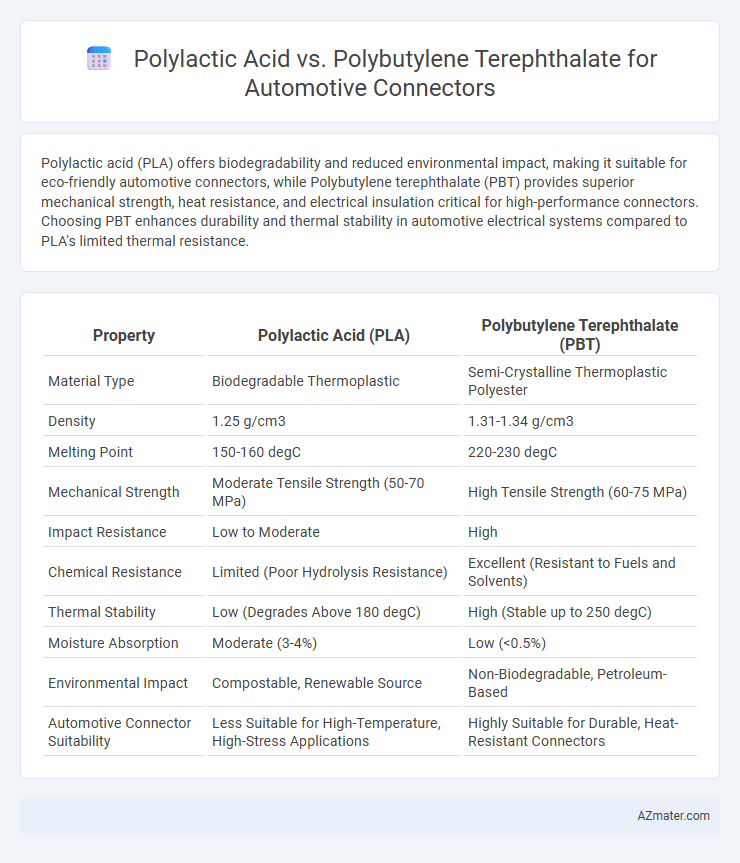Polylactic acid (PLA) offers biodegradability and reduced environmental impact, making it suitable for eco-friendly automotive connectors, while Polybutylene terephthalate (PBT) provides superior mechanical strength, heat resistance, and electrical insulation critical for high-performance connectors. Choosing PBT enhances durability and thermal stability in automotive electrical systems compared to PLA's limited thermal resistance.
Table of Comparison
| Property | Polylactic Acid (PLA) | Polybutylene Terephthalate (PBT) |
|---|---|---|
| Material Type | Biodegradable Thermoplastic | Semi-Crystalline Thermoplastic Polyester |
| Density | 1.25 g/cm3 | 1.31-1.34 g/cm3 |
| Melting Point | 150-160 degC | 220-230 degC |
| Mechanical Strength | Moderate Tensile Strength (50-70 MPa) | High Tensile Strength (60-75 MPa) |
| Impact Resistance | Low to Moderate | High |
| Chemical Resistance | Limited (Poor Hydrolysis Resistance) | Excellent (Resistant to Fuels and Solvents) |
| Thermal Stability | Low (Degrades Above 180 degC) | High (Stable up to 250 degC) |
| Moisture Absorption | Moderate (3-4%) | Low (<0.5%) |
| Environmental Impact | Compostable, Renewable Source | Non-Biodegradable, Petroleum-Based |
| Automotive Connector Suitability | Less Suitable for High-Temperature, High-Stress Applications | Highly Suitable for Durable, Heat-Resistant Connectors |
Introduction to Automotive Connector Materials
Polylactic acid (PLA) and Polybutylene terephthalate (PBT) are prominent materials used in automotive connectors, each offering unique chemical and mechanical properties. PBT provides superior thermal stability, chemical resistance, and dimensional stability, making it ideal for high-performance environments in automotive electrical systems. PLA, derived from renewable resources, offers biodegradability and environmental benefits but lacks the high-temperature resistance required for demanding automotive connector applications.
Overview of Polylactic Acid (PLA)
Polylactic acid (PLA) is a biodegradable thermoplastic derived from renewable resources like corn starch and sugarcane, offering excellent environmental benefits for automotive connectors. PLA exhibits good tensile strength, dimensional stability, and transparency but has lower heat resistance and impact strength compared to polybutylene terephthalate (PBT). Its biodegradability and sustainable sourcing make PLA an attractive option for eco-friendly automotive applications, though PBT remains preferred for high-performance connector components due to superior thermal and mechanical properties.
Overview of Polybutylene Terephthalate (PBT)
Polybutylene Terephthalate (PBT) is a thermoplastic polyester renowned for its excellent mechanical strength, chemical resistance, and dimensional stability, making it ideal for automotive connectors subjected to harsh environments. PBT exhibits superior thermal stability, withstanding continuous operating temperatures up to 150degC, and offers excellent resistance to moisture and automotive fluids compared to Polylactic Acid (PLA). Its inherent flame retardancy and high dielectric strength ensure reliable electrical insulation and enhanced safety in automotive connector applications.
Mechanical Properties: PLA vs PBT
Polybutylene terephthalate (PBT) offers superior mechanical properties compared to polylactic acid (PLA) for automotive connectors, including higher tensile strength, impact resistance, and thermal stability, making it more suitable for demanding automotive environments. PBT's robustness ensures consistent performance under mechanical stress and elevated temperatures, whereas PLA's brittleness and lower heat deflection temperature limit its application in automotive connector manufacturing. The dimensional stability and chemical resistance of PBT further enhance connector longevity and reliability in automotive systems.
Thermal Stability Comparison
Polylactic acid (PLA) exhibits lower thermal stability with a melting point around 150-160degC, making it less suitable for high-temperature automotive connectors compared to Polybutylene terephthalate (PBT), which offers superior thermal resistance up to 220-230degC. PBT's enhanced thermal stability ensures better performance under engine compartment conditions, resisting deformation and maintaining mechanical integrity. This thermal advantage positions PBT as the preferred choice in automotive connector applications requiring consistent operation at elevated temperatures.
Chemical Resistance in Automotive Environments
Polylactic acid (PLA) exhibits limited chemical resistance in automotive environments, especially against fuels, oils, and solvents, which can degrade its structure over time. Polybutylene terephthalate (PBT) offers superior chemical resistance with robust stability against hydrocarbons, brake fluids, and engine oils, making it highly suitable for automotive connectors exposed to harsh chemical conditions. The enhanced durability of PBT ensures reliable electrical performance and longevity in demanding automotive applications where chemical exposure is frequent.
Processability and Manufacturing Differences
Polylactic acid (PLA) offers superior biodegradability but presents processing challenges in automotive connector manufacturing due to its lower thermal stability and slower crystallization rate compared to polybutylene terephthalate (PBT). PBT excels in injection molding with faster cycle times and better dimensional stability, making it ideal for high-precision connector components requiring robust mechanical properties. Manufacturing with PBT benefits from higher melting temperature and superior chemical resistance, enabling more efficient large-scale production and durable automotive connectors.
Sustainability and Environmental Impact
Polylactic acid (PLA) offers superior sustainability for automotive connectors due to its biodegradability and derivation from renewable resources like corn starch, significantly reducing reliance on fossil fuels. Polybutylene terephthalate (PBT), while durable and chemically resistant, is petroleum-based and less environmentally friendly, generating higher carbon emissions during production and lacking biodegradability. The environmental impact of PLA aligns with automotive industry goals for reducing lifecycle carbon footprint and promoting circular economy practices through compostability and reduced plastic waste.
Cost Analysis: PLA vs PBT for Connectors
Polybutylene terephthalate (PBT) generally offers a cost advantage over polylactic acid (PLA) for automotive connectors due to its established production scale and superior thermal and mechanical properties, reducing long-term maintenance expenses. PLA, while biodegradable and derived from renewable resources, typically incurs higher raw material and processing costs that can impact overall manufacturing budgets. Evaluating total cost of ownership favors PBT in high-performance connector applications where durability and resistance to automotive environments are critical.
Application Suitability and Industry Trends
Polylactic acid (PLA) is gaining traction in automotive connectors due to its biodegradability and sustainable sourcing, making it ideal for interior components where environmental impact is a priority. Polybutylene terephthalate (PBT) offers superior thermal resistance, chemical stability, and mechanical strength, which is critical for connectors exposed to high temperatures and harsh automotive environments. Industry trends increasingly favor PBT for under-the-hood applications, while PLA is explored for lightweight, eco-friendly designs aligning with the automotive sector's shift towards sustainability and reduced carbon footprints.

Infographic: Polylactic acid vs Polybutylene terephthalate for Automotive Connector
 azmater.com
azmater.com